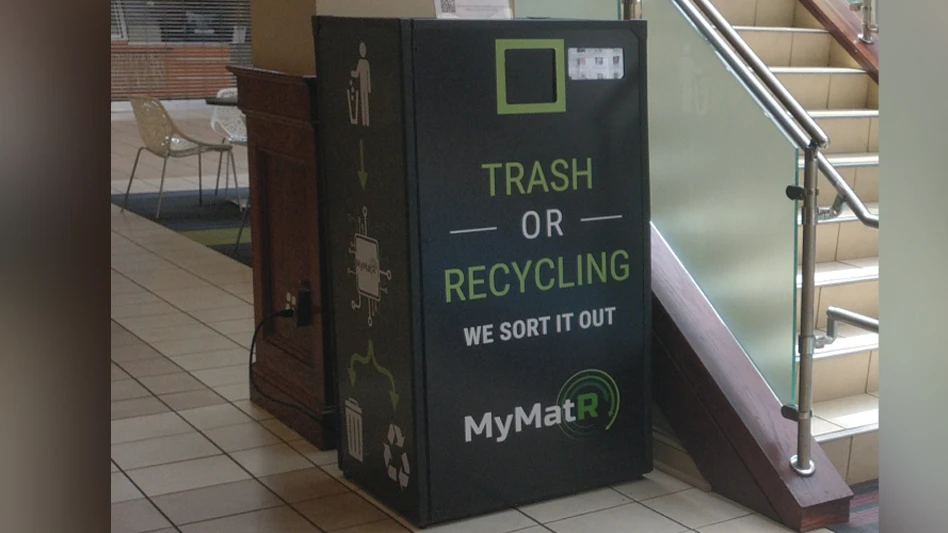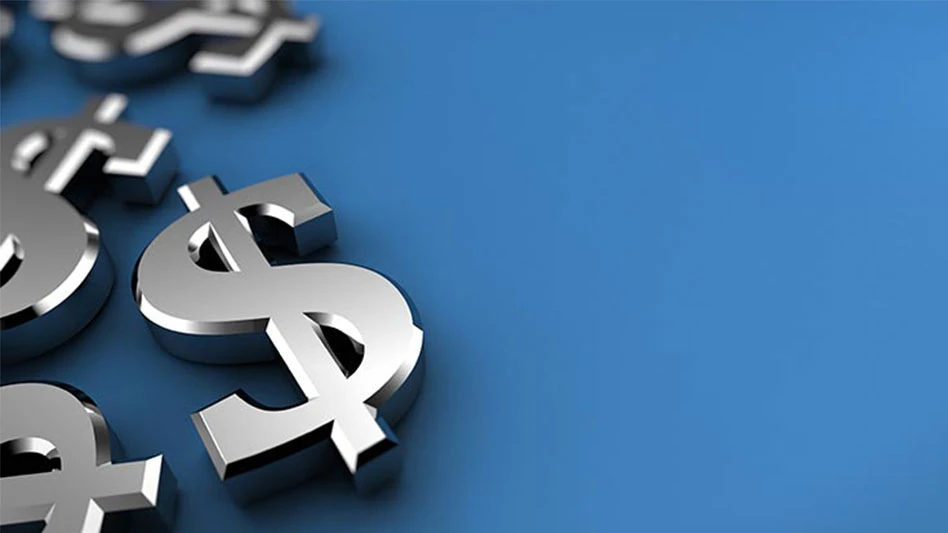
Image courtesy of MyMatR
Since 2021, MyMatR has sought to leverage artificial intelligence (AI) to improve waste management at the source while providing recycling education for users.
Based in Raleigh, North Carolina, the startup has developed smart bins for any environment designed to separate recyclables from the waste stream using AI sensor-based sorting.
The company currently has units—which stand 54 inches high and up to 38 inches wide, depending on customer specifications—deployed at sites that include universities such as Clemson and High Point and Volvo and BMW facilities in South Carolina. Each unit contains two bins, one for waste and another for recycling, which come in 23- or 36-gallon sizes and can be programmed to separate materials such as plastic bottles or aluminum cans from other discarded items with the help of sensors strategically placed inside the unit.
But, according to MyMatR founder and CEO John Starke, the key to unlocking the product’s potential is through its ability to collect data for customers while interacting with users.
“There was a whole other element we were lacking [at the start of this year] and it was the communication of the data,” says Starke, who holds a degree in materials science and engineering from North Carolina State University and worked in manufacturing and engineering before starting MyMatR. “People were putting things in this black box and it’s like, ‘OK, what now?’ And this is where we built out a dashboard to say here’s the picture of the data, here’s how we translate that item into an impact number, such as dollars or carbon emission reductions.
“The other revelation we had was that this is a trash can,” he continues. “People just toss [items] in, and they don’t care, and you just move on with your day. But our customers are really heavily focused on education. … And from this revelation, we realized we had to have the interactive model, where you can choose trash or recycling, or it could be configured to composting, metal cans [and more]. We have that customization, but you choose it, we’ll check it and sort it to where it’s supposed to go, and with our embedded display screen provide that feedback that says, ‘Hey, you did a good job.’”
Starke considers the addition of the display screen to the MyMatR unit to be a “gamification” element that will allow them to choose how to sort their discarded items and provide them feedback on that choice within three seconds.
“And then the automatic sorting is ensuring we’re properly disposing [of items]," he adds. "We’re putting waste in its proper place."
Fitting in
The smart bins MyMatR produces are designed to be customizable, from their branding and size to what materials they will separate.
“We’re highly customizable because we recognize the variety and the chaos in the waste industry,” Starke says. “Everybody wants something different.”
The most recent customizable element the company has added is the configuration of the machine’s inputs, which can be as large as 26 inches or as small as 8 inches. A MyMatR unit also can have one or two inputs. In the future, the units will be able to sort materials into four or five bins.
As far as what the bins will sort, Starke says, “Do you want glass going to your recycling stream, or do you want glass going to your landfill? Do you want to have a container that is situated to just collect cans and bottles, and then everything else goes to trash? We have that ability to use these multiple label categories and that allows the customer to say, ‘Well, this is what we want going where.’ We recognize we have to be flexible to accommodate the myriad of different ways people throw away waste.”
Starke wants MyMatR units to be able to accept any type of material found in commercial and municipal streams that ultimately goes to the market. When it comes to deployment, he says the company is focused on high-traffic areas, such as lobbies, airports, public arenas, hospitals or manufacturing plants.
“We’re looking at anywhere where municipal solid waste is deposited,” he says. “But we are intelligently looking at how we deploy these.”
Data usage
For MyMatR customers, data collection can help them get closer to zero-waste goals while cutting down on contamination and improving the quality of items being sent to material recovery facilities (MRFs).
With the aid of the sensors built into each unit and a customer dashboard Starke says is still being built out, an impact summary can be generated for those customers to see how their machine is performing. Each machine is equipped with fullness sensors that let the customer know when to empty them. Additionally, the dashboard tracks how many people deposited an item, the total weight of items diverted from landfills, carbon emission reductions, total recyclable items captured, diversion percentage and more.
“We are calculating these carbon emission reductions and value avoided from landfill from pretty standard calculations that are out there that say, ‘Look, if you were to fully go through the whole process of recycling an aluminum can, this is the estimated energy savings and carbon emission savings you would realize’,” Starke says. “We want to be as fully transparent as possible for our customers. We don’t guarantee this. We’re just showing you the potential of what can happen if your whole system is streamlined and more efficient.”
Starke adds that the company is seeking additional customer feedback as it continues to build out its data tracking.
In the meantime, as MyMatR continues to engage potential new customers around the United States and improve upon its smart bin design, Starke says he is focused on helping customers achieve better material disposal and recycling at the source of generation.
“What we recognize is a lot of organizations want to achieve zero waste, and we’re trying to help them achieve that goal,” Starke says. “We call it the ‘Three E’s,’ which are engagement, education and ensuring proper disposal.”
Latest from Recycling Today
- Aqua Metals secures $1.5M loan, reports operational strides
- AF&PA urges veto of NY bill
- Aluminum Association includes recycling among 2025 policy priorities
- AISI applauds waterways spending bill
- Lux Research questions hydrogen’s transportation role
- Sonoco selling thermoformed, flexible packaging business to Toppan for $1.8B
- ReMA offers Superfund informational reports
- Hyster-Yale commits to US production





